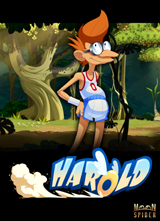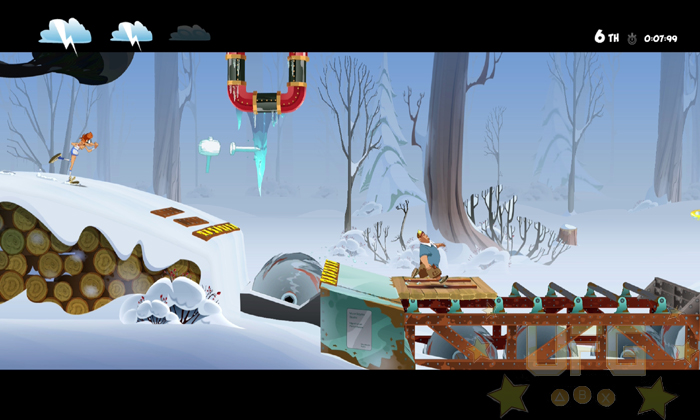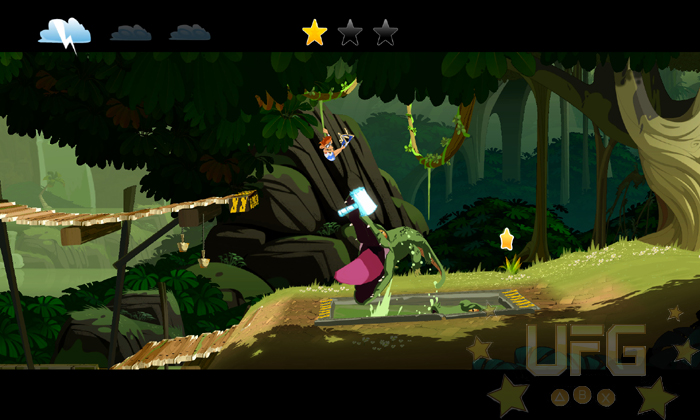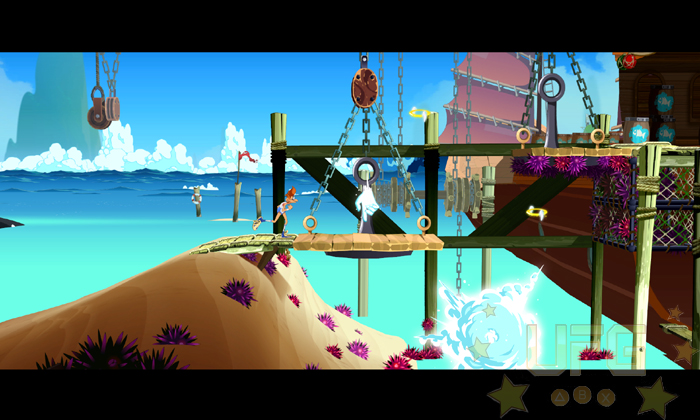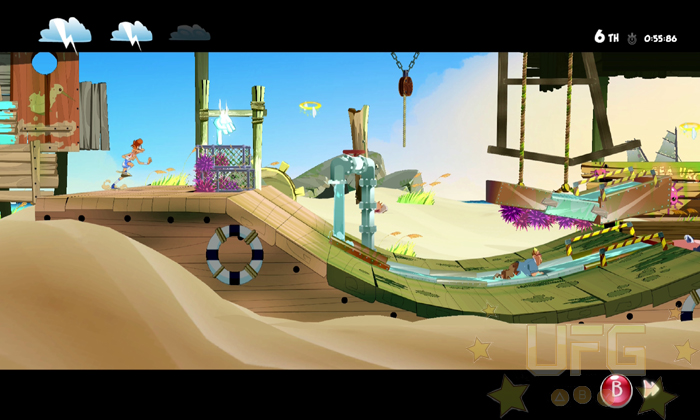Harold
One of the things I like about platformers is how they hone the inherent observational skills needed to progress through them. Most titles in this genre feature levels that are designed to feel more or less like a series of small puzzles. In order to make it from point A to B, gamers need to be aware of certain environmental cues that warn them of danger; there’s a reason why I can tell that a particular platform won’t hold my weight for long in a game I’ve never played. And while this sort of learning can be attributed to gaming in general, I feel that this genre excels at teaching gamers to pay attention to what’s going on beyond more immediate threats, like a band of baddies.
Moon Spider’s Harold is the archetypical platformer as it boils down the platforming into literal puzzle solving. Before I get into that though, let’s check out the plot, which actually explains why the game is designed this way. Harold puts you in the shoes of Gabriel, a guardian angel in training who naturally excels at everything he does. Unfortunately for him, the final test before graduation is a series of races involving humans. Each angel is assigned a human and must help him or her win these races while making sure they avoid any danger. Due to some trickery by a rival, you get stuck with Harold; a clumsy weakling who’s more likely to get himself killed than make it to the finish line. If this wasn’t already a tough spot for Gabe, each race course is filled with deadly obstacles.
In order to help Harold along, you’ll need to use your heavenly powers to either alter the environment or “encourage” him to move the way you’d like. During a race you’ll notice that there are visual clues informing you on how to proceed. A blue hammer would appear in front of a low wall, prompting you to break it down to allow Harold to run past. One blue hand pointing down or up above a platform means that it can be lowered or raised respectively. Two blue hands grasping ropes connecting to a bridge, when snapped, will push quickly and safely push Harold across. When it comes to Harold himself, the same type of manipulation applies. For instance, pressing the jump button will cause a lightning bolt to strike Harold’s backside getting him over pits and onto platforms.
It takes a lot of muscle memory to play this game. Just like in endless running games, you don’t have direct control over Harold. This means that he’ll keep moving towards the finish line whether it’s safe for him to do so or not. As he runs you’ll be scrambling around to move platforms, lower bridges, destroy obstacles etc. Not only that, but you’ll also need to slow down the other racers. Hindering them is done the same way you’d help Harold. Moving a platform right after a racer jumps towards it will make them fall into a pit, giving Harold a few seconds to run by. It’s an interesting way of playing a plafformer. It’s similar to older games because most of what you do boils down to timing. Then again, it’s different because you aren’t the one actually doing the running and jumping.
While this set up is interesting, I don’t know if I’d call it fun. The reason I say this is because, quite frankly, I sucked at it! This is the first game that I’ve ever played where I questioned my dexterity –is it possible that my fingers just can’t move fast enough to clear each level? One reason I felt this way was because of the controls. For instance, there are draw bridges that either needs to be raised or lowered to allow for Harold’s safe passage. To do so, you have to rotate the left analog stick in a particular direction – clockwise for down and counterclockwise for up. I don’t know if I’m not moving the analog properly or if the game just isn’t registering my inputs but I consistently missed the timing. This mechanic isn’t anything new though. I’ve played countless games where I had to rotate the sticks to unlock a door or complete some kind of mini-game and I never experienced this much of trouble.
Then there were the parts of a race that had multiple, interconnected traps/platforms. These sections were difficult not because I didn’t understand what to do but because my hands didn’t always react the way I wanted them to. You see, when you are controlling one obstacle, you’re locked in and can only move in a way that makes sense based on that particular obstacle. If you’re holding the hammer to beat down a wall, only moving the analog back and forth will cause the hammer to move. Pressing in any other direction won’t have an effect. The same thing goes if you’re hands are hovering above a platform (only up and down will register). When more than one of these obstacles are on screen at once, you’ll have to press the right and left triggers to move back and forth between them. For whatever reason, when in tense moments my brain picks up the wrong information. I’ll try and move between each obstacle with the analog stick even though I know it won’t work.
What should happen is I move the stick right and left to break the wall, hit the right trigger to pick the platform closes to Harold, then press down to lower it in time for him to run onto it. Instead, I may break the wall and then move the stick in the direction of the platform or press the right trigger too quickly, moving off of the obstacle before I’m done with it. Now what I just wrote may seem easy (I purposely simplified the situation so you’d understand) but in-game things can get really complicated really fast. There are some platforms that when moved affect others nearby, multiple pits to jump over, ropes to cut, pillars to lean and so forth. And because Harold just keeps trotting away, there’s very little time to catch your breath.
To be fair, before you can even play a new level, you have to go through a practice run. During this run you’ll get to play on each section of the course to familiarize yourself with the obstacles and traps. There are also multiple paths to the finish line to choose from with the best ones being highlighted during these practice runs. So it isn’t like you aren’t prepared well before going into a race. Adding to this is the fact that if you fail a jump or get crushed by a killer whale, you aren’t completely out of the race. The game gives you multiple chances; the power used to speed up Harold also allows him to respawn seconds after dying. As long as you have some power left, you’ll be able to keep Harold going. With all that being said, I still had a hard time helping Harold to finish in the top three spots and he never made it in first.
What I want to make clear is that Harold isn’t a bad game. It’s very possible to develop the skills needed to ace each race by either memorizing the layout of each course or by developing the muscle memory in order to react quickly after recognizing an obstacle. Bettering your times and finishing strong can be fun. I just couldn’t get things to click well enough to enjoy myself. And the fact that I don’t know whether it’s my lack of skill or the controls themselves that causes my frustration, it’s hard for me to recommend the game outright. This is a shame really, as I liked everything else. The animations harp back to classic Disney cartoons, there are a decent number of levels (including unlockable challenges), the music is nice, and although the story isn’t anything special I was interested in what happened to Gabriel. Unfortunately, for me, Harold just couldn’t keep up with the rest of the game!
Gameplay:
7
The times when everything works as they should, Harold is a fun platformer. For me personally, those times were short lived.
Graphics:
8
The vibrant color pallet and smooth animations are great to gawk at, even if you aren’t winning!
Sound:
8
Though there aren’t that many tracks, the music were pleasant to listen too.
Replay Value:
7
There are 12 courses to race on, challenge courses, and leaderboards to compare your runs with others. So, there’s reason to go back through the game. Really, it depends on whether or not you’re having fun.
Final Score:
7.5
